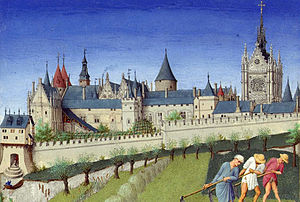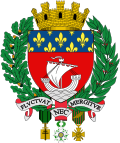


| History of Paris |
|---|
 |
| See also |
|
|
Roman Republic 52–27 BC
Roman Empire 27 BC–AD 395
Western Roman Empire 395–476
Kingdom of Soissons 476–486
Francia 486–843
West Francia 843–987
Kingdom of France 987–1792
French First Republic 1792–1804
First French Empire 1804–1814
Kingdom of France 1814–1815
First French Empire 1815
Kingdom of France 1815–1830
July Monarchy 1830–1848
French Second Republic 1848–1852
Second French Empire 1852–1870
French Third Republic 1870–1871
Paris Commune 1871
French Third Republic 1871-1940
Military Administration in France 1940–1944
∟ part of German-occupied Europe from 1940 to 1944
Provisional Government of the French Republic 1944–1946
French Fourth Republic 1946–1958
French Fifth Republic 1958–present
The oldest traces of human occupation in Paris are human bones and evidence of an encampment of hunter-gatherers dating from about 8000 BC, during the Mesolithic period.[1]
Between 250 and 225 BC, the Parisii, a sub-tribe of the Celtic Senones, settled on the banks of the Seine, built bridges and a fort, minted coins, and began to trade with other river settlements in Europe.[2]
In 52 BC, a Roman army led by Titus Labienus defeated the Parisii and established a Gallo-Roman garrison town called Lutetia.[3] The town was Christianised in the 3rd century AD, and after the collapse of the Roman Empire, it was occupied by Clovis I, the King of the Franks, who made it his capital in 508.
During the Middle Ages, Paris was the largest city in Europe, an important religious and commercial centre, and the birthplace of the Gothic style of architecture. The University of Paris on the Left Bank, organised in the mid-13th century, was one of the first in Europe. It suffered from the Bubonic Plague in the 14th century and the Hundred Years' War in the 15th century, with recurrence of the plague. Between 1418 and 1436, the city was occupied by the Burgundians and English soldiers. In the 16th century, Paris became the book-publishing capital of Europe, though it was shaken by the French Wars of Religion between Catholics and Protestants. In the 18th century, Paris was the centre of the intellectual ferment known as the Enlightenment, and the main stage of the French Revolution from 1789, which is remembered every year on the 14th of July with a military parade.
In the 19th century, Napoleon embellished the city with monuments to military glory. It became the European capital of fashion and the scene of two more revolutions (in 1830 and 1848). Under Napoleon III and his Prefect of the Seine, Georges-Eugène Haussmann, the centre of Paris was rebuilt between 1852 and 1870 with wide new avenues, squares and new parks, and the city was expanded to its present limits in 1860. In the latter part of the century, millions of tourists came to see the Paris International Expositions and the new Eiffel Tower.
In the 20th century, Paris suffered bombardment in World War I and German occupation from 1940 until 1944 in World War II. Between the two wars, Paris was the capital of modern art and a magnet for intellectuals, writers and artists from around the world. The population reached its historic high of 2.1 million in 1921, but declined for the rest of the century. New museums (The Centre Pompidou, Musée Marmottan Monet and Musée d'Orsay) were opened, and the Louvre given its glass pyramid.
In the 21st century, Paris added new museums and a new concert hall, but in 2005 it also experienced violent unrest in the housing projects in the surrounding banlieues (suburbs), inhabited largely by first and second generation immigrants from France's former colonies in the Maghreb and Sub-Saharan Africa. In 2015, the city and the nation were shocked by two deadly terrorist attacks carried out by Islamic extremists. The population of the city declined steadily from 1921 until 2004, due to a decrease in family size and an exodus of the middle class to the suburbs; but it is increasing slowly once again, as young people and immigrants move into the city.
- ^ "Le Monde Planete, sur les traces des premiers Parisiens". Le Monde. Retrieved March 3, 2017.
- ^ Combeau, Yvan, Histoire de Paris, Presses Universitaires de France, 1999, p. 6.
- ^ Schmidt, Lutèce, Paris des origines à Clovis (2009), pp. 88–104.